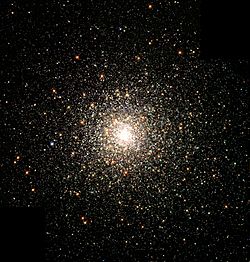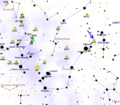Messier 80 facts for kids
Quick facts for kids Messier 80 |
|
|---|---|

|
|
| Observation data (J2000 epoch) | |
| Class | II |
| Constellation | Scorpius |
| Right ascension | 16h 17m 02.41s |
| Declination | –22° 58′ 33.9″ |
| Distance | 32.6 kly (10.0 kpc) |
| Physical characteristics | |
| 5.02×105 M☉ | |
| Estimated age | 12.54 |
| Other designations | M80, NGC 6093, GCl 39 |
| See also: Globular cluster | |
Messier 80 (also known as M80 or NGC 6093) is a huge group of stars called a globular cluster. It is found in the constellation Scorpius, which looks like a scorpion. A French astronomer named Charles Messier discovered it in 1781.
Contents
What is Messier 80?
M80 is one of the most crowded globular clusters in our Milky Way galaxy. It holds hundreds of thousands of stars packed closely together. You can find M80 between two bright stars in Scorpius: Antares and Beta Scorpii. This area of the Milky Way is full of nebulae, which are giant clouds of gas and dust.
How to See M80
Even a small amateur telescope can show M80. It looks like a fuzzy, mottled ball of light. M80 appears about 10 arcminutes wide in the sky. This is about one-third the size of the full Moon.
Size and Distance
M80 is very far away, about 32,600 light-years from Earth. A light-year is the distance light travels in one year. This cluster is huge, stretching about 95 light-years across.
Blue Straggler Stars
M80 has many special stars called blue stragglers. These stars look much younger than the rest of the cluster. Scientists think blue stragglers form when stars get too close to each other. They might lose their outer layers or even crash into each other.
Images from the Hubble Space Telescope show many blue stragglers in the center of M80. This suggests that stars often collide or interact there.
The Nova of 1860
On May 21, 1860, something amazing happened in M80. A nova was discovered within the cluster. A nova is a sudden, bright burst of light from a star. This nova was named T Scorpii.
T Scorpii became very bright, reaching a magnitude of +7.0. For a short time, it shone brighter than the entire cluster! This event showed how powerful and dynamic these star clusters can be.
Images for kids
See also
 In Spanish: Cúmulo globular M80 para niños
In Spanish: Cúmulo globular M80 para niños



